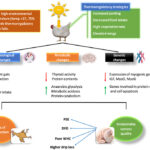Gene Bank Management and Operation:
Gene banks, also known as seed banks or germplasm banks, are crucial for preserving genetic diversity and ensuring the conservation of plant and animal species. Here are key aspects of gene bank management and operation:
Collection and Preservation: Gene banks collect and preserve genetic material (seeds, embryos, tissues, etc.) from a wide range of species. Proper storage conditions, including temperature and humidity control, are crucial to maintaining seed viability.
Documentation: Each genetic sample is meticulously documented, including information on its source, characteristics, and genetic traits. Digital databases are often used for record-keeping.
Regeneration: Periodic regeneration of seeds or plant materials is necessary to maintain genetic integrity. This involves growing plants from stored seeds and replenishing the bank’s holdings.
Quality Control: Quality control measures, including germination tests and genetic analyses, are conducted regularly to ensure the viability and authenticity of stored materials.
Access and Sharing: Access to genetic resources is typically regulated to prevent misuse. Researchers and breeders can request access for scientific and breeding purposes, often subject to international treaties and agreements.
Security: Gene banks employ strict security measures to protect against theft, natural disasters, and equipment failures that could jeopardize the stored genetic material.
Public Awareness Strategies:
Raising public awareness about biodiversity conservation is crucial. Effective strategies include:
Education Programs: Develop and implement educational programs in schools and communities to teach people about the importance of biodiversity and conservation.
Media Campaigns: Use television, radio, social media, and other platforms to disseminate information about biodiversity, threatened species, and conservation efforts.
Public Events: Organize workshops, seminars, and public events focused on biodiversity, inviting experts and conservationists to speak.
Collaboration with NGOs: Partner with non-governmental organizations (NGOs) and environmental groups to amplify conservation messages and engage in community-based conservation initiatives.
Nature Reserves and Ecotourism: Promote ecotourism to raise awareness and generate income for conservation efforts. Visitors can learn about biodiversity and contribute to local economies.
Population Explosion:
Managing population growth is a critical aspect of sustainable development and biodiversity conservation. Strategies include:
Family Planning: Promote family planning programs to provide access to contraception and reproductive health services.
Education: Invest in quality education, especially for girls and women, which tends to lead to smaller family sizes.
Healthcare: Improve access to healthcare services, reducing child mortality and increasing life expectancy, which often leads to smaller families.
Economic Opportunities: Create job opportunities, especially in rural areas, to reduce the economic reliance on larger families.
Awareness: Educate communities about the environmental impact of rapid population growth and the benefits of family planning.
Biodiversity Action Plan for Pakistan:
A biodiversity action plan for Pakistan would involve:
Assessment: Conduct a comprehensive assessment of Pakistan’s biodiversity, identifying key species, habitats, and threats.
Stakeholder Engagement: Involve government agencies, NGOs, local communities, and experts in the planning process.
Conservation Priorities: Determine conservation priorities, including protecting critical habitats, managing endangered species, and addressing invasive species.
Legislation and Enforcement: Strengthen and enforce environmental laws and regulations related to biodiversity conservation.
Habitat Protection: Establish and manage protected areas, conserving critical ecosystems and promoting sustainable land use practices.
Public Awareness: Implement public awareness campaigns to engage communities in biodiversity conservation efforts.
Research and Monitoring: Support scientific research to better understand biodiversity and monitor the effectiveness of conservation actions.
International Collaboration: Collaborate with neighboring countries and international organizations to address transboundary conservation issues.
Capacity Building: Build the capacity of local institutions and communities to manage and conserve biodiversity effectively.
Sustainable Development: Integrate biodiversity conservation into national development plans and policies to ensure a balance between economic growth and environmental protection. A biodiversity action plan would provide a roadmap for Pakistan to conserve its rich natural heritage and contribute to global conservation efforts.





Excellent
Easy to understand